BA'AL
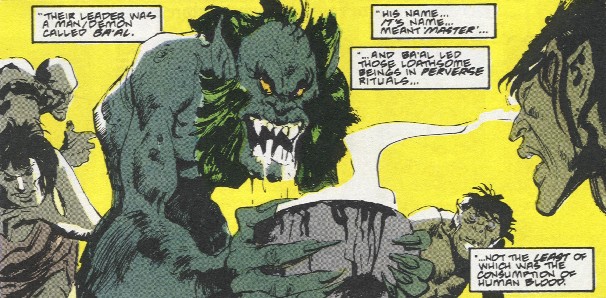
Real Name: Ba'al-Hadad
Hadad is his Sumerian name.
“Ba'al” is a title meaning “Lord.” “Bel”
is its feminine counterpart.
Identity/Class: Mesopotamian God/Demon (Class Two)
Occupation: demon
former King of the Mesopotamian Gods;
God of wind, rain, storm and fertility
Group Membership: The Mesopotamian
Gods (formerly?)
Affiliations: Formerly worshipped by a number of races, including the Acheronians, Assyrians, Babylonians, Hittites, Hurrians,
Philistines, Canaanites/Phoenicians, Sumerians, and the people of
Gehenna;
also worshipped by Amanuensis, the Brotherhood of Ba'al and the Followers of Ba'al (possibly the same beings), Sà-Bal-Bal (the Spawn of Ba'al) and his monster;
Ice Box Bob (pawn)
Enemies: Prince Baran, Craig + Emma + John
Blaze, Archie and Burt Corrigan, Dagon/Enlil,
Hand of God, Jesse Pinto, Tetrarchs of
Entropy, Ullikummis,
Wendigo
(see comments), Wolverine
Known Relatives: Anu (father, SEE COMMENTS),
Asherah (mother), Anath (wife),
Inar, Zintuki (sons);
Dagon , Ninurta, Martu (brothers);
Inanna
(sister)
Nergal, Nusku, Kinyras, Gibil
(half-brothers);
Ningal, Zarpandit, Ninlil, Gatumdug, Gula (half-sisters);
Ea (uncle), Mami, Damkina, Eriskegal
(aunts);
Dumuzi, Shamash, Nanna, Ullikummis (nephews);
Marduk
(cousin);
Sà-Bal-Bal (descendent)
Aliases: Adad (Babylonian), Teshub (Canaanite name),
Iskur
(Hittite Name), Taru (Hattic name), Tesup (Hurrian name);
The Voracious, The Unforgiving, the Immutable, the Unfathomable;
Lord (the translation of Ba'al)
the vampire lord Varnae
has in the past usurped Ba'al's name for his own purposes
Place of Birth: Nippur, Sumeria (now part of modern Iraq)
Base of Operations: An unspecified extra-dimensional
nether realm
formerly Arinna, Sumeria;
later Mount
Saphon (both now part of modern Iraq) and Gehenna
Extent of Education: Unrevealed
First Appearance: Wolverine II#11 (Early September,
1989, Behind the Scenes);
(Spawn of Ba'al) Wolverine II#12
(Ba'al fully seen) Wolverine II#13
Powers/Abilities: Ba'al possesses superhuman powers
above most of the Mesopotamian Gods.
While his original powers are unclear, his demonic form is
virtually immune to conventional injury (or able to be reformed
after being damaged or destroyed). Its spirit is virtually
immortal, and can survive the physical destruction of its form.
Via the Gehenna
Stone, he was able to send his power
into his Spawn, granting him increasingly levels of power as the
Stone was reassembled. At full power, Ba'al appeared to be
virtually invulnerable, could generate powerful flames from his
hands or eyes, and had an uncertain degree of superhuman strength
(Class 25 - 100?).
The incarnation that encountered Blaze had
similar powers. Though it was unable to access Earth on its own,
it could penetrate the dimensional barriers if they were weakened
by other means, and did not seem to have any dependence on the
Gehenna Stone.
Height: 9'3"
Weight: 1490 lbs.
Eyes: Red
Hair: None
History
: (Mesopotamian myth) - Hadad is the son of Anu,
king of the Mesopotamian Gods, and Asherah, Mother of the Gods. Anu,
however, was overthrown by his son, Enlil, who became Dagon,
father of the gods.
Hadad, however, defended heaven and assisted the sea god, Ea,
by killing Apsu, the divine water god. In gratitude, Ea supported
Hadad in overthrowing Dagon and forcing him into exile. As the
new ruler of the gods, Hadad became known as Ba'al-Hadad and
eventually just Ba'al.
Anath, the sun-goddess, however, began slaughtering many of
Ba'al’s worshippers as she demanded the secret of lightning
from him. Establishing herself as a war-goddess, she persuaded Ea
to have a house created by Ba'al on the top of
Mount Saphon.
Once the artisan-god Kinyras completed the house, she presented
herself to Ba'al as his wife and equal and became Queen of the
Gods.
In his exile, Dagon fathered the giant Ullikummis, but
Shamash, the sun-god saw them approaching from a far and warned
Ba'al. Ba'al briefly abdicated the throne as Dagon once more
usurped his rule. Ba'al fled to Ea for advice on how to defeat Ullikummis
and received a sacred saw with which to saw through his ankles.
Wounding the giant and then killing him, Ba'al overthrew Dagon
and regained the throne.
Ba'al, however, eventually decided he had to know the secrets
of life and death. He traveled to Allatum, the Mesopotamian
underworld, and met with Mot, the god of death who served as
vizier to Eriskegal, Queen of the Underworld and goddess of the
dead. Explaining he had come for the secrets of life and death,
Ba'al was invited by Mot to eat off the table of the dead as he
went to retrieve Eriskegal. They both then revealed that since he
had eaten from the table of the dead that he could not leave Allatum
and Ba'al died. Anath then learned the truth and challenged Mot.
Defeating him, she had Mot return Ba'al to life just before she
killed him.
Tiamat, however, still threatened earth since the death of Apsu,
her consort. She was finally killed by the wisdom-god, Marduk,
son of Ea, the sea-god. Ea soon sponsored Marduk to replace Ba'al
as Ruler of the Gods especially as the Babylonian tribes
conquered and assimilated the Ancient Sumerians on earth. Because
of Marduk’s divine role as the slayer of Tiamat, Ba'al had
no choice but to abdicate his position of power to him.
BTS - Over time, without worshippers, Ba'al
apparently degenerated into a more demonic entity (see comments).
(Savage Sword of Conan#10) - Ba'al was
worshipped as early as 13, 000 BC, in the nation of Acheron.
Around 10,000 BC, the resurrected Acheronian sorcerer Xaltotun
invoked Ba'al in a struggle against the sorcerer Hadrathus.
See comments
(Thor & Hercules: Encyclopedia Mythologica) - At some point Ba'al was approached by Satan (Marduk Kurios), who tempted him with everlasting power. Ba'al accepted the deal and was transformed into a demon.
(Blaze II#8 (fb) - BTS) - Around 1000 BC Amanuensis became a High Priestess of Baal. She was mummified after her death and rested in an undead state, waiting for the return of Baal to Earth.
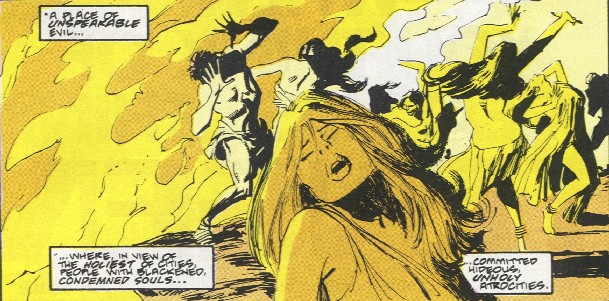 (Wolverine
II#13(fb)) - Millennia later, Ba'al led the people of Gehenna,
which was just outside of Jerusalem, and was considered by them
to be the foulest place on Earth. It had started out as a charnel
pit, where the refuse of Jerusalem burned their refuse, and Ba'al
transformed it into a place of unspeakable evil. Ba'al led the
people of Gehenna in perverse rituals, including human sacrifice
and the consumption of human blood.
(Wolverine
II#13(fb)) - Millennia later, Ba'al led the people of Gehenna,
which was just outside of Jerusalem, and was considered by them
to be the foulest place on Earth. It had started out as a charnel
pit, where the refuse of Jerusalem burned their refuse, and Ba'al
transformed it into a place of unspeakable evil. Ba'al led the
people of Gehenna in perverse rituals, including human sacrifice
and the consumption of human blood.
God was so disgusted by what he beheld, that he sent a fierce
warrior: He was known only as the Hand of God, and armed with
unbreakable steel and divine right, he smote the demon Ba'al.
Even in his death-throws, Ba'al perpetuated his evil. What passed
as his soul coalesced over him, and entered a glittering, multi-faceted
gem that his followers had prepared for him. What they had not
prepared for was the righteous wrath of the Hand of God. They
fought that mighty warrior in, but in vain. Finally, on a field
bloody with corpses, the Hand of God stood before the last
incarnation of Ba'al and smashed it asunder. The evil of Ba'al
was trapped into a hundred fragments, and not content with that,
the Hand of God hurled the pieces to the four winds, never to be
assembled, until doomsday...
(Tower of Shadows#7/2 - BTS) - Baal was invoked by a gypsy to avenge her daughter killed by "Black John" Wollaston. The curse placed on the Wollastons endured for centuries.
(Wolverine II#13(fb)) - In more recent
centuries, pieces of the Gehenna Stone were unearthed at
archeological digs, and wound up in various museums and private
collections.
(Giant-Size Werewolf by Night#2 - possibly BTS)
- A group known as the Brotherhood of Ba'al attempted to
sacrifice Lissa Russell in an effort to gain the power to
transfer the soul of the Frankenstein monster into a more normal
body. These efforts were foiled by the monster and the Werewolf (Lissa's
brother), and those who survived the initial slaughter did not
appear to escape when the burning building fell off a cliff (see
comments).
(Wolverine II#13(fb)) - Slowly, over a two year
period, the descendent of Ba'al directed the Followers of Ba'al
of to begin assembling the fragments of the Gehenna Stone.
(Wolverine II#13(fb)) - Seeing a fragment of
the Gehenna Stone in the San Francisco Museum of Antiquities,
Burt Corrigan was seized by the need to have it. Using his wealth,
Corrigan got himself onto the Board of Directors of the museum.
Once there, he made a switch, replacing the true fragment with a
replica, and keeping the original for himself.
(Wolverine II#11 - BTS) - Ernst and Jarocha, a
pair of the Followers of Ba'al, robbed the San Francisco Museum
of Antiquities, intending to steal the fragment of the Gehenna
Stone being held there. The two attracted the attention of a
guard, but they mortified him by bearing their fangs, and he fell
easy victim to them. However, the fragment shattered as they were
stealing it, revealing itself to be a fake.
Meanwhile, a trial was being prepared to judge the sanity of Burt
Corrigan. He put on a great show of responsibility when his
brother (alongside Patch/Wolverin) visited him, but as soon as
they left, he returned to staring at his precious gem. Corrigan
showed up late (and on horseback) to his sanity hearing the next
day, with a group of the Followers of Ba'al following closely
behind.
In addition, Tuttle, the curator of the Museum, hired Jessica
Drew to locate the real fragment of the Gehenna Stone, and to
investigate the seeming vampires who had stolen it.
(Wolverine II#12) - Wolverine, Archie, and Burt
were joined by Jessica in fighting and escaping the Followers of
Ba'al. The Spawn of Ba'al used the Gehenna Stone (or most of it,
anyway) to prophesize that his followers would drive the fragment
holders to him.
(Wolverine II#13) - As predicted, the fragment's
holders headed towards a California airstrip, right where the
Spawn of Ba'al and more of his minions were waiting. The
Followers of Ba'al assaulted them, while the Spawn drew the
attention of Wolverine, and then blasted him out of the air when
he leapt at him. The Spawn laughed off several slashes from
Wolverine's claws then caught the mutants wrist and tried to rend
him limb from limb. Tried, and failed. However, Wolvie couldn't
break his grip, either, and the Spawn channeled energy through
Wolverine that started to cook him. Wolverine finally got in a
good claw swipe across the Spawn's face, and the Spawn hurled him
across the tarmac. However, one of the Followers of Ba'al had
managed to knock out Burt and take his fragment, and so the Spawn
led the Followers to depart in rapid fashion.
(Wolverine II#14) - As the Spawn and the
Followers flew a plane towards Madripoor and the final fragment
of the Gehenna Stone, Wolverine, Archie, Burt, and Jessica caught
up to them in a plane of their own. Wolverine and Jessica boarded
the plane, overpowering most of the Followers, including one that
the Spawn had mutated into a monstrous and powerful form.
Wolverine destroyed Ba'al's plane and escaped and returned
Jessica to Archie's plane, but they failed to reveal the fragment.
Ba'al himself laughed as the plane went down in flames, and his
smiling face could be seen in the flames as it exploded.
(Wolverine II#15) - In Madripoor, while some of
the Followers of Ba'al attempted to locate the last gem fragment
by slaughtering anyone who had come near it, the Spawn of Ba'al
headed to the palace of Prince Baran, who had received the
fragment. The Spawn of Ba'al introduced himself as a trader, who
wished to make him an offer for the fragment, and Baran accepted
him as a guest.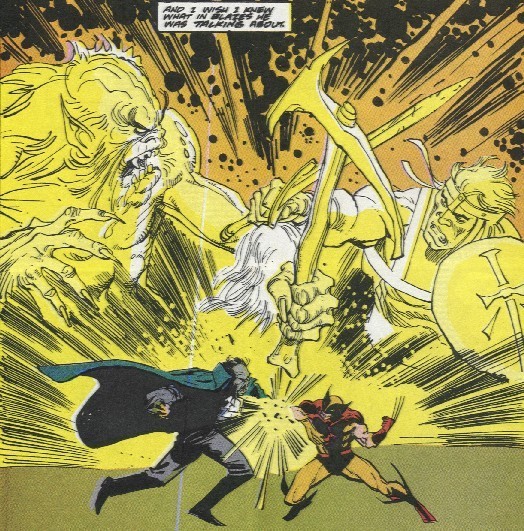
(Wolverine II#16) - The Spawn offered Baran
immortality in exchange for the fragment, and Baran told him that
he would sleep on the offer. Unwilling to wait any longer, Ba'al
demanded the fragment, and then determined that it was within
Baran's servant, Johann, who had swallowed it to keep it hidden.
The Spawn of Ba'al simply thrust his hand into Johann and tore
the fragment from his body. The Spawn easily threw off Baran and
Jessica Drew's attempts to subdue him, and he placed the last
fragment into the Gehenna Stone. His soul complete, Ba'al was
reformed within his descendent, and his Followers were
transformed into vampiric creatures, instead of posers, as they
had been. However, for all his power, Ba'al became quite nervous
when Wolverine entered the fray. As the two slashed at each other,
Ba'al continued to tell him that he wouldn't defeat him again,
and that his time was past. Ba'al finally began to project energy
from the Gehenna Stone that began to fry his attacker. Wolverine
ernestly prayed for assistance, and received it, apparently being
possessed by the Hand of God. Shattering the Stone with a sweep
of his claws, Wolverine then skewered Ba'al--releasing his
powerful energies--and then tackled him out of the castle and
into the sea below. Ba'al pulled himself to the shore, but then
crumpled into a lifeless heap.
BTS - Though the Ba'al-Spawn was apparently
slain in the preceding conflict, Ba'al himself was only injured,
though his spirit was banished from the Earthly plane. At some
point he encountered Icebox Bob, an evil human whose spirit had
been dispatched to the same nether realm as Ba'al.
Sometime Ba'al also managed to obtain Craig and Emma Blaze, the
children of John Blaze, in hopes that Blaze would travel to the
nether realm and free him.
(Blaze II#3) - Ba'al accused Icebox Bob of
attempting to steal the children from him. Ba'al instructed Bob
to manipulate the Eyes of the Kristall Starrer to communicate
with Blaze's ally, Clara Menninger, to direct him to a road that
would bring Blaze to their realm. With the aid of Bob's enemy,
Holden Blevins, Blaze destroyed Ice Box Bob, but Ba'al dragged
Craig and Emma back into his realm before Blaze could claim him.
(Blaze II#4) - Ba'al confronted Blaze in a
vision, taunting him with their future meeting. In a later,
collective vision, Ba'al taunted Blaze with his holding his kids.
Meanwhile, Darryl Licht, a grad student over at the State
University performed a ritual hoping to gain power from Native
American trickster god. However, Ba'al received his summons
instead, and transformed Licht into the Anung-Ite, a powerful,
monstrous, magical creature. All the time Licht utilized the
power of the Anung-Ite, the energies paved the way for Ba'al's
transport to Earth.
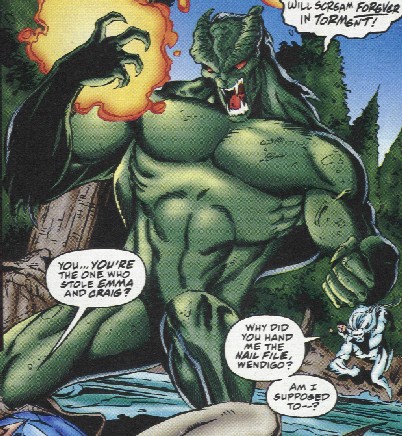 (Blaze
II#5) - Whilst Licht fought Blaze and Warpath, back in the nether
realm, Ba'al taunted the Blaze children. However, the pair were
then joined by Jesse Pinto, a young boy whose family had been
slain by Licht. Jesse carried a weapon against magic: an iron
nail file marked with the number 7. Their cell was then entered
by a bizarre incarnation of the Wendigo, who was following energy
from the Eyes of the Kristall-Starrer. The Wendigo took the nail
file and walked back out through the far wall, returning to Earth.
It gave the file to Blaze, who used it to neutralize Licht's
power and returned to normal.
(Blaze
II#5) - Whilst Licht fought Blaze and Warpath, back in the nether
realm, Ba'al taunted the Blaze children. However, the pair were
then joined by Jesse Pinto, a young boy whose family had been
slain by Licht. Jesse carried a weapon against magic: an iron
nail file marked with the number 7. Their cell was then entered
by a bizarre incarnation of the Wendigo, who was following energy
from the Eyes of the Kristall-Starrer. The Wendigo took the nail
file and walked back out through the far wall, returning to Earth.
It gave the file to Blaze, who used it to neutralize Licht's
power and returned to normal.
(Blaze II#6 (fb)) - The Wendigo returned to the
cell holding Jesse and the Blaze kids. This time when it passed
out of the far wall, the three kids leapt onto its back and
escaped back to Earth with him. However, the repeated travels to
and from the nether realm weakened the barrier between realities,
and Ba'al managed to escape the nether realm as well. As they
passed between realities, they encountered the Tetrarchs of
Entropy, who sought to escape their Dimension of Exile. Ba'al
blasted the Tetrarchs aside and continued to follow the Wendigo
back to the Earthly plane.
(Blaze II#6) - John Blaze observed his children
return to Earth aboard the Wendigo's back, but as his motorcycle
roared towards them, he failed to hear their warnings as Ba'al
appeared behind him. Finally seeing Ba'al's reflection in the
chrome on his motorcycle, Blaze blasted him with hellfire, to
little effect. Ba'al fired an eye-blast that knocked Blaze from
his cycle, but the Wendigo then attacked Ba'al. As the two
separated, Blaze attacked with a series of blasts from his
hellfire shotgun, but Ba'al continued to advance on him and
blasted him to the ground once again. Ba'al prepared to slay
Blaze, but Jesse Pinto leapt out Ba'al, stabbing him in the right
arm with the #7 nail file. The iron disrupted Ba'al's magic
energies and blew his arm off. His foothold on Earth weakened by
his injuries, Ba'al was now susceptible to Blaze's hellfire, and
he fled back his realm to renew his power. Jesse Pinto directed
the Wendigo to follow Ba'al, so they could destroy him in his
weakened form. Craig & Emma accompanied Jesse and the Wendigo,
despite their fathers calls to them.
(Blaze II#8 - BTS) - High Priestess of Baal Amanuensis awakened when Baal attempted to manifest on Earth, but he was thwarted by Johnny Blaze. Amanuensis swore to take revenge on Blaze and offered herself as Baal's vessel of Earth, but Johnny Blaze shot, and seemingly slew her with his Hellfire shotgun.
(Blaze II#10) - At some point later, the
Wendigo and three children had captured Ba'al, pinning him to the
ground (or what passed for ground) in another reality.
Before Pinto could use the mystical nail file to kill Ba'al, the
demon showed them that the tool was needed to help Blaze's father,
and couldn't be used for both.
(Blaze II#11 - BTS?) - Faced with which to use
the file for, the children opted to help Blaze. The four
then proceeded to travel back to Earth.
Comments
: Adapted by Peter David and John Buscema.
The Brotherhood of Ba'al seemed to just be a
bunch of Satanists, and they may have just taken the name b/c
they mistook it for another aspect of Satan. However, if they did
indeed worship Ba'al, it is possible that they were influenced by
the Spawn of Ba'al. If so, it could then follow that over time,
the cultists not slain (and/or not present) in the struggle
against Franky and the Werewolf could have gone on to become the
group known as the Followers of Ba'al.
While it could be that the demon Ba'al was not
the same being as the Mesopotamian God Ba'al (i.e. the demon was
lying, usurping the name of the god to gain his leaders), this is
not how the story was intended. I'm certainly not the expert on
mythology and religions that some of the profilers for this site
are, but as I see it, the Hebrew religion existed around the time
of the some of those lumped into the Mesopotamian line (such as
the Philistines). As a monotheistic religion, they saw other
pagan religions as evil, and saw their gods as demons.
Anyway, virtually all of the Mesopotamian gods that have been
seen in the modern era have taken on some degree of a demonic
nature (Marduk, or an aspect of him (Marduk Kurios), has used
the name Satan, and is the father of Hellstorm). It could be
that without worshippers, the gods degenerated into a demonic
state (see Will's thoughts below). It also could be that
as the gods ceased to be worshipped, their ties to Earth grew
progressively weaker. Perhaps some died, perhaps some passed on
to other planes, and perhaps some just severed all contact. It
could be that demons then began usurping their name and their
worship. It has also been shown that in some cases, i.e. Set and
Seth, that the god actually usurped the name and the worship of
the demon who had preceded it.
Still, I tend to think that the writers were indeed intending the
characters they used to be the original gods, or the demons that
those gods were thought to be.
Interestingly, if Marduk is the Satan in the Hellstorm stories,
then I'd cast my vote that the "God" seen in that
series is actually Enlil (Dagon).
Also, it is not certain that the two Ba'als (the
one from Wolverine and the one from Blaze) are the same being.
However, each references similar worshippers (the people of
Gehennna and the Canaanites respectively), so I'm going with them
as the same until proven otherwise.
Jessica Drew proposed that since the Ba'al that
they had faced was a direct descendent or a reincarnation of the
original, that Wolverine might have a similar relationship to the
Hand of God.
Jess: "What does that make you?"
Wolv: "Thirsty."
Anyway, I'm not sure that there had to be any pre-existing
relationship, but rather Wolverine just might have served as the
vessel for the Hand of God.
The Gehenna Stone Affair was my personal
favorite Wolverine story arc of any of his series. Peter David is
a master.
This was also the storyline where pretty much everyone in
Madripoor revealed that they had known Patch was Wolverine all
along, but that they had played along, both out of respect for
his desires and out of trepidation of what might occur if they
crossed the angry little mutant.
The Blaze storyline (written by Larry Hama) was...it was...what
the H? was it?
And speaking of that, what was up with that incarnation of the
Wendigo? Though it appeared exactly the same as its predecessors
and successors, it wasn't the typical mindless, carnivorous
monster as in virtually every other appearance. It was this
benevolent creature summoned by magic and dedicated to saving
Blaze's kids...or something. It made no sense to me, and was
never explained.
In Wolverine#13, Gehenna was described as a
Charnal Pit, which apparently either confused on combined the two
words charnel (in reference to a slaughterhouse) and carnal (referring
to the body, as in Carnal Knowledge (referring to intercourse).
It may have been a mistake, but I could see Peter David as having
sought both meanings.
Baal was invoked in SSOC#131/2 in a Kull
story, so he was around in the Pre-Cataclysmic era.
--Per Degaton
Jean-Marc Lofficier adds: The Children of Ba'al
were originally meant to be regular vampires, of the Drac variety.
There were made into the Children of Ba'al when we complained,
and our editor (Mike Rockwitz) complained to Peter's editor, and
the change was forced upon his story.
He is
called "Lord Prince" or "Baal Zebul"
(-> Beelzebub, Hebrew for "Lord of the Insects"
-> "Lord of the Flies)
Will's comments
"Ba'al is two
things; One it was the name of Hadad as a short time ruler of the
gods, and second: it was a word/title meaning god. It was used in
Ba'al-Hammon, Ba'al-Athirat, Ba'al-him, Ba'al-her.
Technically, it was Ba'al-Hadad and then
just Ba'al. The Hebrews really hated this figure. They never
cared much for any of the old Sumerian gods, but the Babylonian
gods in their newer forms really got a bad rep.
When the Assyrian Empire came to power, guess
what, another word, more titles. There were gods Nin-Girsu, Nin-Karrak
and Ninhursag (used slightly differently for goddesses, Ninhursag
was a name for Mother Earth/Gaea)."
There is some confusion in the broken texts
of the Mesopotamian hieroglyphics regarding the relationships of
Ba'al-Hadad toward Dagon-Enlil, Martu, Ninurta and Anu,
especially where it concerns their multiple aliases, conflicting
importance in different religions and the various translations
and possible misinformation over thousands of years. Dagon is
quite often called the son of Ba'al, while Enlil is often called
the father of Hadad; In Hurrian myth they are referred to as
brothers. However, Ninurta, the god of storm, is often called
protector of the south wind and his brother Martu, the god of
drought, the protector of the west wind. If Ba'al-Hadad and Dagon-Enlil
represent east and north, if would make them all sons of Anu, god
of sky and heaven as well as remain true to the established
pattern already seen in other pantheons. (Boreas, Eurus, Notus
and Zephyros in the Olympian Pantheon; Tezcatlipoca, Mixcoatl, Camaxtl
and Xipe Totec in Aztec myth; Morozkho, Vetru, Varpulis and Dogoda
in Russian lore; and Puhuri, Ahava, Etelatar and Nyrctes of the
Finnish Epics.)
Aspects of Ba'al’s life resemble: Cronus
getting overthrown by Zeus; Persephone trapped in the underworld
after eating the food of the dead; and (where Ullikummis is
concerned) Achilles’ weakness in his ankles.
At least in the Marvel Universe, it could
be assumed that Ba'al was the first of the Annunaki (Mesopotamian
Gods) to degenerate into a demon given his death and reanimation
by Mot, and then spreading the contamination through the other
gods as a result. It could be assumed that some of the Annunaki,
such as Ereshkigal could still possess their godhood while others
have become demons.
The Sumerians are considered
the oldest of all human empires, although even the Egyptians come
pretty close. The Sumerians were conquered by the Babylonians and
then by the Assyrians. There was then an interim as several races
kept preventing each other from developing an empire as great as
the previous rules. This includes the Hittites, Hattic races,
Arabs, Canaanites, Phoenicians, and Philistines. They were all
subjugated by the Romans.
Gehenna
According to the American Heritage Dictionary (
http://www.bartleby.com/61/8/G0070800.html ):
| SYLLABICATION: |
Ge - hen - na |
| PRONUNCIATION: |
 g g -h -h n n  |
| NOUN: |
1. A place or
state of torment or suffering. 2. The abode of
condemned souls; hell. |
| ETYMOLOGY: |
Late Latin, from Greek Geenna,
from Hebrew gê’ hinn m, possibly
short for gê’ ben hinn m, possibly
short for gê’ ben hinn m, valley of
the son of Hinnom, a valley south of Jerusalem : gê’,
valley of, bound form of gay’, valley; see gy m, valley of
the son of Hinnom, a valley south of Jerusalem : gê’,
valley of, bound form of gay’, valley; see gy in Appendix II + hinn in Appendix II + hinn m,
personal name; see hnn
in Appendix II. m,
personal name; see hnn
in Appendix II. |
per http://crain.english.mwsc.edu/revelation/gehenna.htm
Gehenna. The place where,
according to Jesus in the synoptic Gospels, sinners are
punished after death. A few times Hades (See Hell) is also treated as
such a place of punishment (Matthew 11.23; Luke 10.14; Luke 16.23), but it is cited more
often as the realm of death in general. (The NRSV translates
Grk. geenna as "hell.")
Gehenna
was originally the Hebrew name of a valley just south of
Jerusalem’s southwestern hill (Joshua 15.8) called "the
valley of Hinnom" (gÙ<
hinn¿m) or "the
valley of Hinnom’s son(s)" (gÙ< ben(ê) hinn¿m); Map 9. Under
the influence of the Aramaic form gÙhinnŒ(m), the Greek
transliteration of the word became geenna. "Hinnom"
may be understood as the representative of a Jebusite group
that once dominated the place in question, but the Bible
mentions only the valley. In boundary lists it forms the
border between Judah and Benjamin south of the Jebusite city
(Joshua 15.8; Joshua 18.16), implying that
Jerusalem belonged to Benjamin.
The
later view of Gehenna as a place of punishment, especially by
fire, is anticipated in an Isaianic reference to a large
topheth, or burning place, near Jerusalem, said to be lit by
the Lord to punish the Assyrians and their king (Isaiah 30.33). A further stage in
the development of the relevant concepts is reached in the
report concerning King Josiah’s cultic reform of 622 B.C.,
which implied a desecration of similar topheths in Judah,
especially one found in the valley of Hinnom and dedicated to
Molech for children (2 Kings 23.10; cf. 2 Chronicles 28.3; 2 Chronicles 33.6). The elimination
ordered by Josiah was not entirely successful, for somewhat
later Jeremiah made repeated attacks on the topheth and said
the valley of Hinnom would become a general burial place (Jeremiah 7.31; Jeremiah 19.11; Jeremiah 32.35).
On
the basis of such passages and influenced by parallelism with
Persian ideas of a judgment in fire, Jewish apocalypticism
made the valley of Hinnom a place of punishment within an
eschatological milieu. In a vision ascribed to Enoch a cavity
was depicted, into which the faithful Jews, gathered on the
holy mountain, would look down to see the righteous judgment
and eternal punishment of all godless and cursed people (1
Enoch 26.4; 27.2–3). No name appears here, but since the
details of the picture indicate the topography of Jerusalem,
the cavity in question must have been meant as the valley of
Hinnom. The joining of the eschatological perspective to
Jerusalem then led to an explicit use of the name Gehenna for
that place of punishment, a usage that emerges in texts of
the first century AD in the New Testament (e.g., Matthew 5.22; Matthew 10.28; Matthew 23.15; Matthew 23.33; James 3.6) and in Jewish
apocalypse (e.g., 2 Esdras 7.36, in the Latin translation "Gehenna")
Oxford Companion to the Bible
There are a
bunch of sites discussing Gehenna, from a place where human
sacrifices were performed to a place of literal fire.
Ba'al has a full entry in the All-New OHotMU#1 and a paragraph in the Annunaki entry in the All-New OHotMU Update#3. In the latter it was cleared up that Ba'al was the son of Anu and Asherah and the name Sà-Bal-Bal for Ba'al's descendant became official.
Profile by:
Will U (mythology) and Snood (comic information)
CLARIFICATIONS:
Ba'al is not to be confused with:
- BA'AL
- alias of Varnae, Marvel Comics Presents#63/4
- Baal
(Mr. Gabriel)-agent of Mysterio/Nicholas Macabes,
Daredevil II#3
- Ba'al of Earth-Ba'al,
universal computer from the Earth's future, @ Iron Man I#41
- Ba'al
of the CRIMSON SANDS - Leader of the Sandstormers (a
band of desert raiders), Rise of Apocalypse#1
- Ba'al-PTEOR
of the Hyborian Era - trained by Priests of Yajur as
Strangler of Yota-Pong, agent of Totrasmek, slain by
Conan
--Shadows in Zamboula; Savage Sword of Conan#14
It is not clear whether there are any connections to:
- BEL
of the Hyborian era - Shemite god, legend corrupted in
Zamora to a god of thieves, patron god of Shumir and
Arenjun
--Savage Sword of Conan#212
I add this b/c Bel is the feminine form of Ba'al (which
just means "Lord"), and the Shemites eventually
became the Arabic and Hebrew people. So, maybe there is a
connection. If this is the case, then Ba'al's worship was
active during the Hyborian era (@ 16000 - 8000 BC).
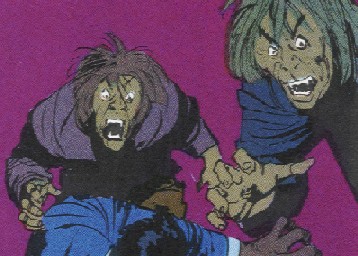 Followers of Ba'al
Followers of Ba'al
aka Children
of Ba'al (I think), these were the human agents of the Spawn of
Ba'al. They disguised themselves as vampires, but didn't have any
true powers. However, when the Spawn gained the full power of Ba'al,
he transformed his followers so that they actually became
vampiric creatures. They presumably reverted when the Spawn was
slain and Ba'al's spirit was banished from Earth.
Ernst,
Jarocha, and Maroney were named.
--Wolverine
II#11 (12-16
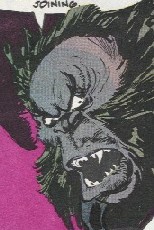
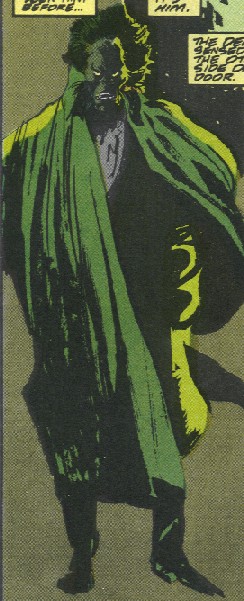 Sà-Bal-Bal
Sà-Bal-Bal
This being
was allegedly the descendent or the reincarnation of Ba'al. He
led the Followers of Ba'al, and he became more like Ba'al himself
as the fragments of the Gehenna Stone were assembled. When the
Stone was complete, Ba'al was reborn within him. He was slain
when Ba'al's spirit was driven from the Earth by Wolverine.
He proved
immune to conventional injury, including Wolverine's attacks--until
Wolverine was possessed by the Hand of God. He had superhuman
strength and durability and could generate great heat. At one
point, his body was apparently consumed in an airplane explosion,
but he later reformed with no deficits.
--Wolverine
II#12 (11-BTS, 12-16
The word
actually comes from the Sumerian language, via information at
this site: http://www.sumerian.org/sumerian.htm
provided by John A. Halloran (and thanks to Kyle Smith for
finding this out for me).
sà-bal-bal:
descendant, offspring ('womb' + reduplicated 'to revolve, deliver').
The "s" is pronounce as sh, like in dash.
I like it,
I like it!
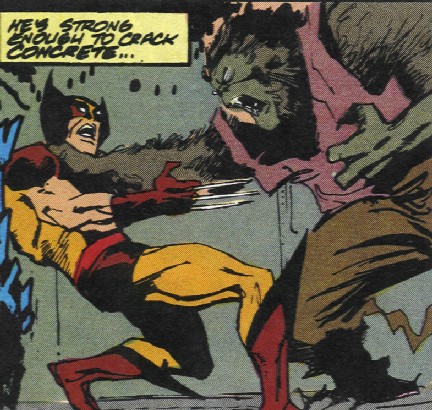 Ba'al's monster
Ba'al's monster
One of the
Followers of Ba'al, he was mutated by the Spawn of Ba'al into a
monstrous creature to fight off Wolverine when he boarded their
plane. He was extremely strong and durable. Even when Wolverine
channeled electricity from the airplane engine into him, he was
merely stunned. However, he was apparently consumed in the
airplane explosion--perhaps Ba'al withdrew his power into himself
to survive.
--Wolverine
II#14
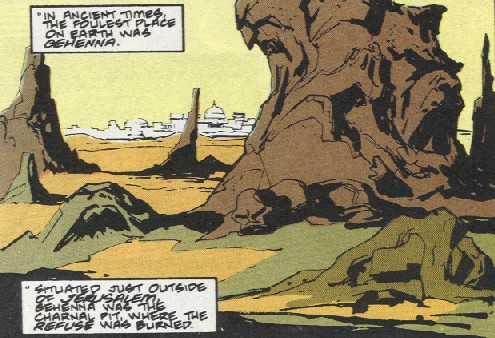 Gehenna
Gehenna
Just outside
of Jerusalem, it was considered by them to be the foulest place
on Earth. It had started out as a charnel pit, where the refuse
of Jerusalem burned their refuse, and Ba'al transformed it into a
place of unspeakable evil. Ba'al led the people of Gehenna in
perverse rituals, including human sacrifice and the consumption
of human blood.
--Wolverine
II#13 (13(fb)
Gehenna is
also referenced in Gambit II#2, where Sybil names Shaitan and
Moloch as the "Last of Gehenna"
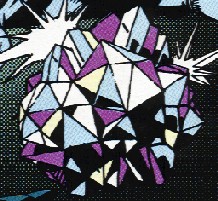 Gehenna Stone
Gehenna Stone
A magical gem
created by Ba'al to contain his spirit when he was slain by the
Hand of God. However, the gem was then shattered by the Hand of
God, and the fragments scattered across the earth. In recent
years the Spawn of Ba'al directed the Followers of Ba'al to begin
reassembling the stone. The fragments caused all around them to
seek to possess them, even to the point of killing their own
friends and relatives to hold the gem. The assembled Stone
allowed Ba'al to be reborn through the Spawn of Ba'al, but the
Hand of God possessed Wolverine, enabling him to shatter the
Stone once again.
--Wolverine
II#11 (13(fb), 11(fb), 11-16
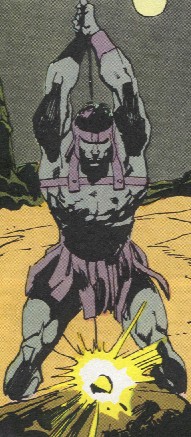 Hand of God
Hand of God
An agent of
God, he was sent to Earth to cleanse it of Ba'al and the people
of Gehenna. He did this successfully and also shattered the
Gehenna Stone, fragmenting Ba'al's soul for millennia. When the
Stone was reassembled and Ba'al reformed in modern years, the
Hand of God possessed Wolverine (who may or may not have been his
descendent), enabling him to shatter the Stone and drive Ba'al
from Earth.
--Wolverine
II#13 (13(fb), 16
Appearances:
Tower of Shadows#7 (September, 1970) - Allyn Brodsky (writer), Barry Windsor-Smith (pencils), vince Colletta (inks), Stan Lee (editor)
Savage Sword of Conan#10 (February, 1976)
Wolverine II#11-16 (early September - mid November, 1989) - Peter David (writer), John Buscema (pencils), Bill Sienkiewicz (inks), Bob Harras (editor)
Blaze II#3-6 (October, 1994 - January, 1995) - Larry Hama (writer), Henry Martinez (pencils), Bud Larosa (inks), Bobbie Chase (editor)
Blaze II#10 (May, 1995) - Larry Hama (writer), Gary Erskine (artist), Marie Javins (editor)
Thor & Hercules: Encyclopedia Mythologica (2009) - Anthony Flamini, Greg Pak, Fred Van Lante & Paul Cornell (writers), Jeff Youngquist (editor)
Last
updated: 07/06/14
Any Additions/Corrections?
please
let me know.
Non-Marvel Copyright
info
All other characters mentioned or pictured are ™ and ©
1941-2099 Marvel Characters, Inc. All Rights Reserved. If you
like this stuff, you should check out the real thing!
Please visit The Marvel Official Site at: http://www.marvel.com
Special Thanks to www.g-mart.com for hosting the Appendix, Master List, etc.!
Back to Characters
 (Wolverine
II#13(fb)) - Millennia later, Ba'al led the people of Gehenna,
which was just outside of Jerusalem, and was considered by them
to be the foulest place on Earth. It had started out as a charnel
pit, where the refuse of Jerusalem burned their refuse, and Ba'al
transformed it into a place of unspeakable evil. Ba'al led the
people of Gehenna in perverse rituals, including human sacrifice
and the consumption of human blood.
(Wolverine
II#13(fb)) - Millennia later, Ba'al led the people of Gehenna,
which was just outside of Jerusalem, and was considered by them
to be the foulest place on Earth. It had started out as a charnel
pit, where the refuse of Jerusalem burned their refuse, and Ba'al
transformed it into a place of unspeakable evil. Ba'al led the
people of Gehenna in perverse rituals, including human sacrifice
and the consumption of human blood.

 (Blaze
II#5) - Whilst Licht fought Blaze and Warpath, back in the nether
realm, Ba'al taunted the Blaze children. However, the pair were
then joined by Jesse Pinto, a young boy whose family had been
slain by Licht. Jesse carried a weapon against magic: an iron
nail file marked with the number 7. Their cell was then entered
by a bizarre incarnation of the Wendigo, who was following energy
from the Eyes of the Kristall-Starrer. The Wendigo took the nail
file and walked back out through the far wall, returning to Earth.
It gave the file to Blaze, who used it to neutralize Licht's
power and returned to normal.
(Blaze
II#5) - Whilst Licht fought Blaze and Warpath, back in the nether
realm, Ba'al taunted the Blaze children. However, the pair were
then joined by Jesse Pinto, a young boy whose family had been
slain by Licht. Jesse carried a weapon against magic: an iron
nail file marked with the number 7. Their cell was then entered
by a bizarre incarnation of the Wendigo, who was following energy
from the Eyes of the Kristall-Starrer. The Wendigo took the nail
file and walked back out through the far wall, returning to Earth.
It gave the file to Blaze, who used it to neutralize Licht's
power and returned to normal.


 Ba'al's
Ba'al's 
 Gehenna
Gehenna 